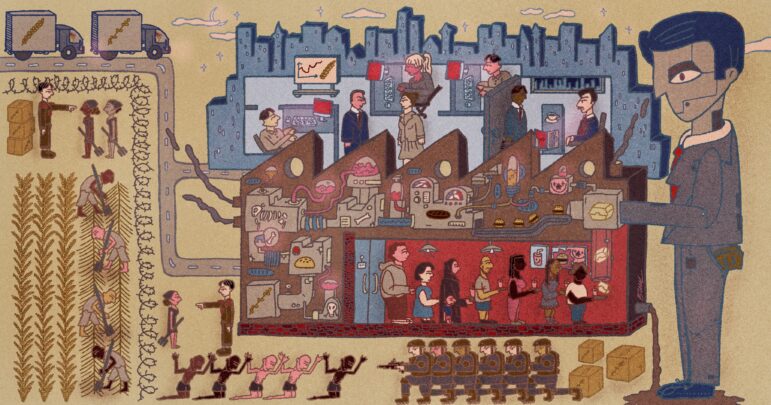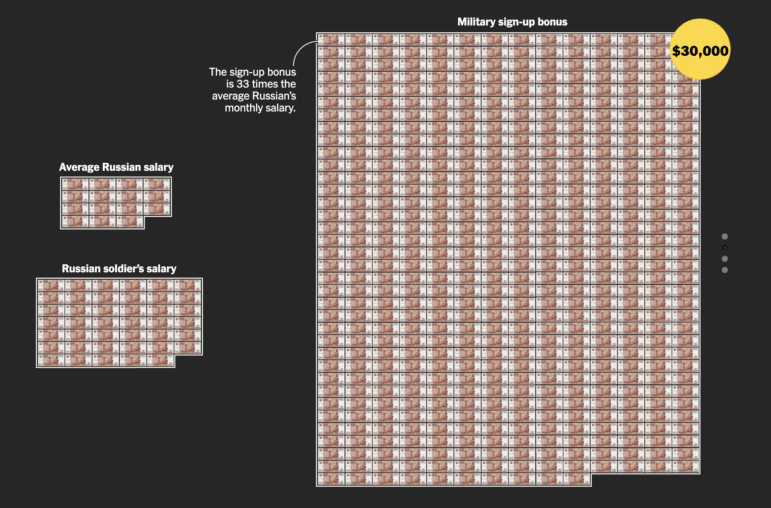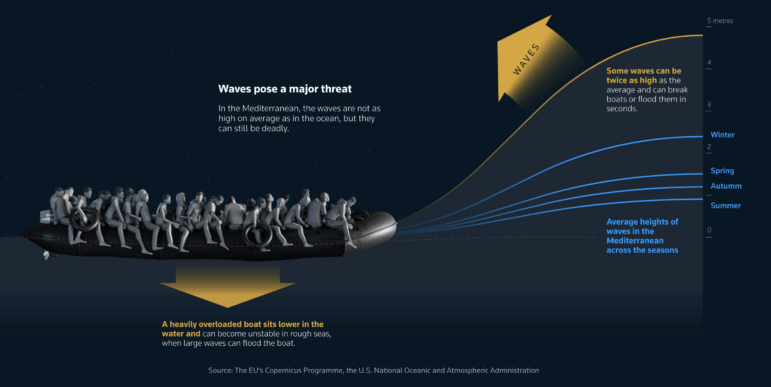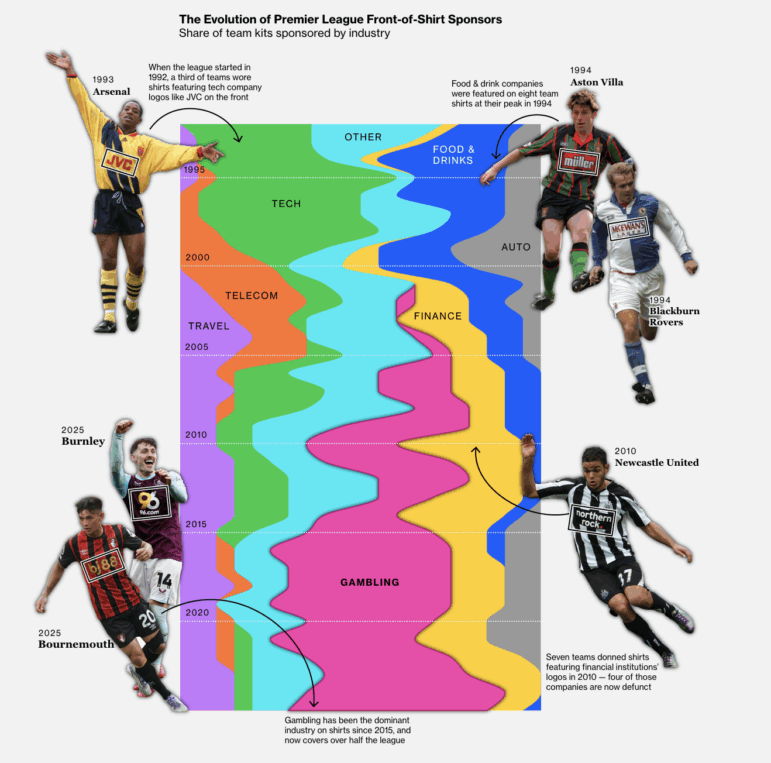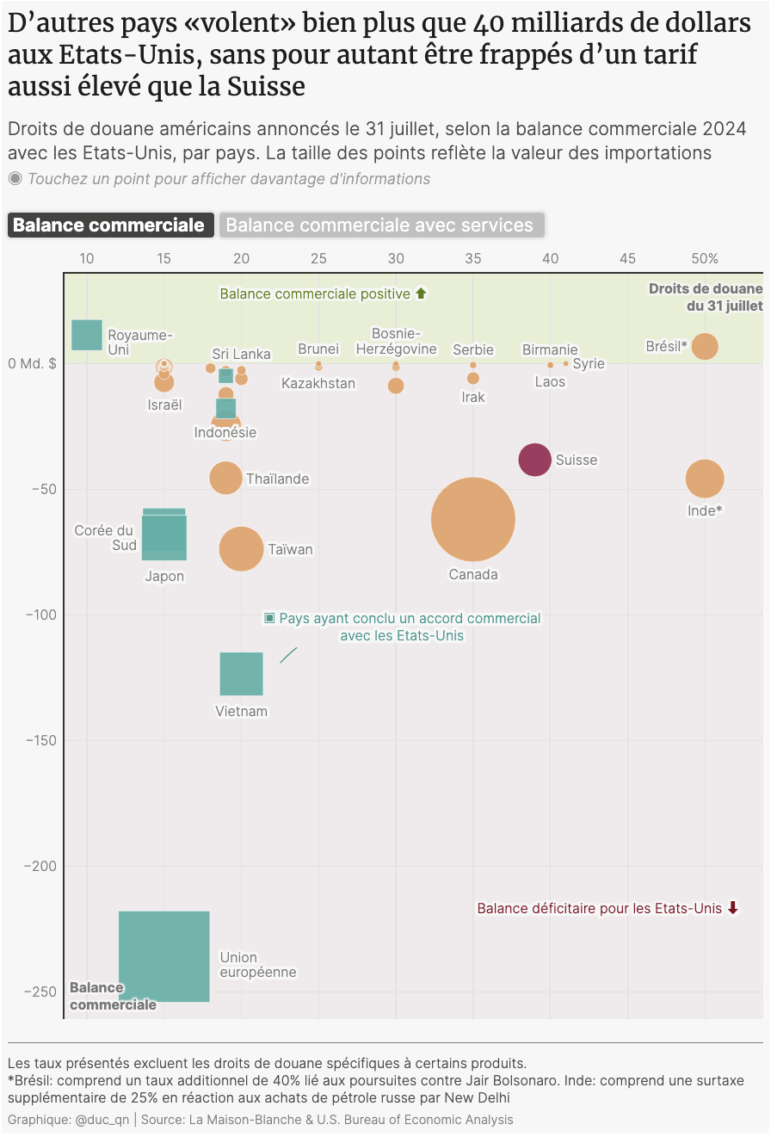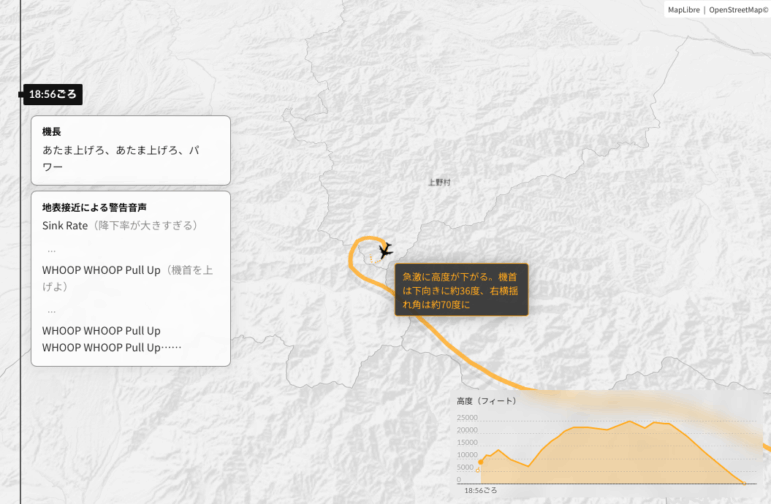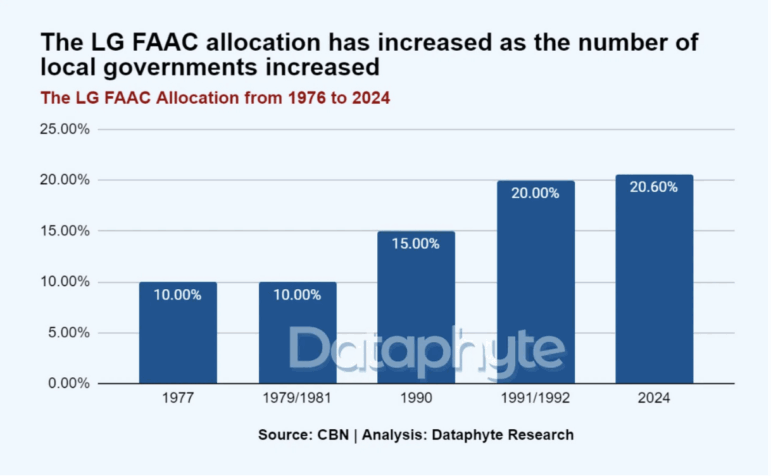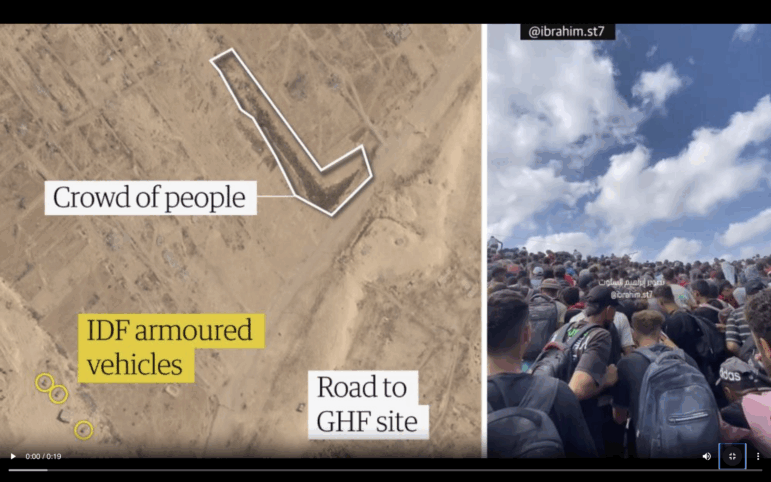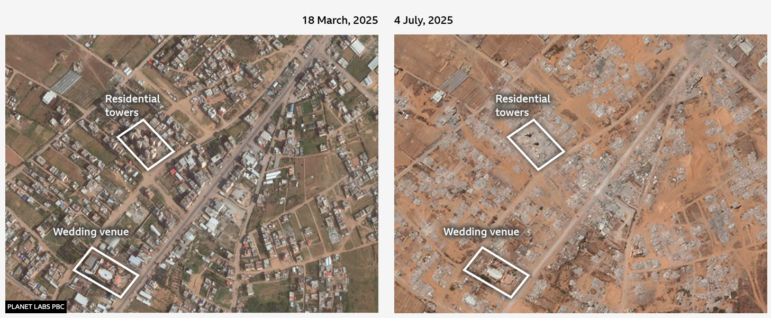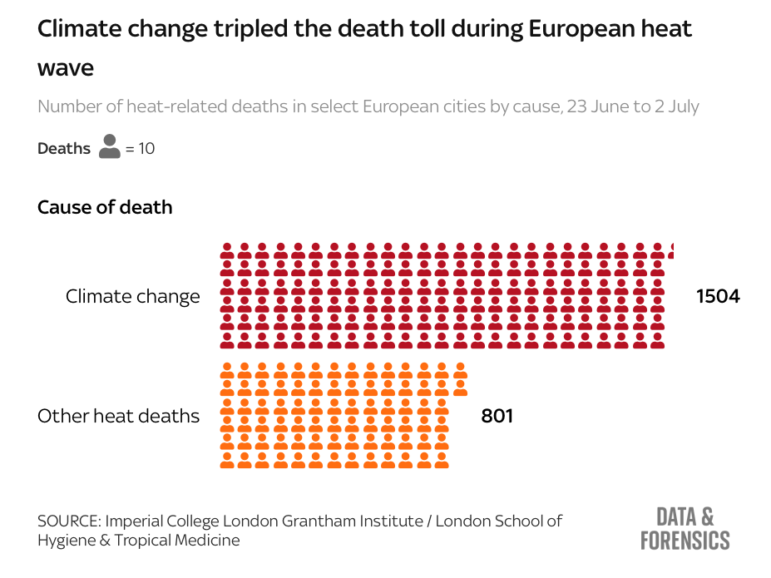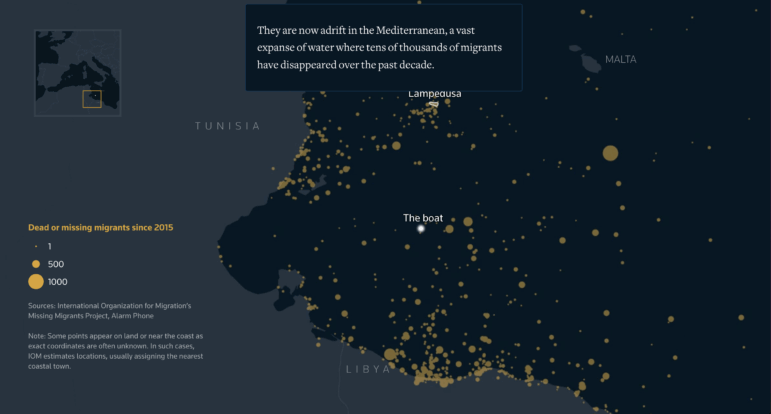

Image: Screenshot, Reuters
Deadly Mediterranean Migration, Putin’s Military Gains, Spain’s Enduring Wildfires, Gambling on Premier League Kits
In this edition of our Top 10 in Data Journalism, covering stories from August 6 to 19, we look at an interactive analysis from The New York Times on Vladimir Putin’s renewed strategic momentum in Ukraine amid potential peace talks, the inconsistent tariff policies of US President Donald Trump, and a compelling Reuters piece that maps the hazardous journeys migrants take as they attempt to reach Europe via the treacherous Mediterranean crossing. Other pieces include an insightful snapshot from Bloomberg on the prevalence of betting companies as sponsors for Premier League football teams, the ongoing deadly hazards facing Palestinians seeking aid in Gaza, and a strong data-driven visualization by Diario Sur tracking the spread — and growing longevity — of wildfires in Spain.
Putin’s Military Upper Hand
In the past week, both Russian and Ukrainian leaders have met US President Donald Trump in efforts to broker a ceasefire. A compelling New York Times interactive explored how Russia’s battlefield resurgence is shaping Vladimir Putin’s push for a deal on his terms, buoyed by lucrative enlistment incentives and a surge in weapons production. Drawing on data from Tatarstan, a region with some of the country’s highest soldier recruitment rates, the piece visualizes military sign-up bonuses, weapons factory subsidies, and the modernizing of Soviet-era bombs into guided munitions. Combined with incursion maps from the Institute for the Study of War (ISW) and frontline drone footage from Telegram channels, the analysis reveals how Moscow is refining its tactics and adapting after early missteps.
Deadly Nature of Mediterranean Migration
Italy has reported a sharp drop in irregular arrivals as proof that its migration policies are working, with Prime Minister Giorgia Meloni and the European Commission crediting deterrence measures. Frontex data shows crossings to the EU fell in 2024 and continued to decline into 2025, driven by fewer journeys via the central Mediterranean. But the Reuters Graphics team counters these claims with data: over 1,300 distress calls logged by Alarm Phone — a support hotline for migrants and refugees crossing in boats — and 3,812 deaths or disappearances, nearly half along this deadly route, according to the International Organization for Migration (IOM). Using Frontex figures, satellite imagery, NOAA ocean analysis, and VesselFinder tracking, the piece reconstructed one dinghy’s ill-fated voyage from Libya with scrollytelling maps and videos from those onboard, revealing how policies hailed as a “success” magnify danger by limiting rescues due to updated Italian laws.
How Betting Companies Are Taking Over Premier League Jerseys
As the Premier League — the highest level in the English football league system — kicked off this week, Bloomberg Graphics examines the evolution of shirt sponsorships since 1992, when the league started. In the league’s early years, sponsors were largely tech or telecom firms, backing 18 clubs between 1992 and 2000. They included household names like Hewlett-Packard (Tottenham) and Brother (Manchester City), but many of those firms are now out of business. Bloomberg explained that back then, with international broadcasting limited, sponsorships catered to local fans in stadiums and on British broadcaster BSkyB — producing a patchwork of distinctly local brands sponsoring teams. This season, more than half the clubs feature gambling brands, marking the culmination of a trend which Bloomberg visualizes in a revealing streamgraph that charts sponsorship sector dominance over three decades.
US Tariffs Against Switzerland
Switzerland has the fourth-highest tariff rate (39%) set by the US as part of President Trump’s mercurial global tariff program. Using data from the US Bureau of Economic Analysis (BEA) and the White House, Swiss French-language daily newspaper Le Temps created a series of data-heavy visuals looking at tariff rates of different countries, and compared how countries that do not have trade deals with Washington — and are running trade surpluses with the US larger than Switzerland’s — are enjoying more lenient tariffs than Bern. Switzerland’s gold exports to the US surged in 2024, artificially inflating its trade surplus and illustrating the extreme volatility in bilateral trade. Le Temps showed that basing tariff calculations on these volatile swings, by Trump’s misguided logic, means that Switzerland would have “stolen” anywhere between US$9 to US$57 billion a year. The newspaper also noted that the 2024 surge in gold prices was driven by investors’ flight to safe haven assets, in part because of uncertainty over economic policy given Trump’s return to office.
Why Spain’s Wildfires Are Taking Longer to Extinguish
Spain is confronting large-scale wildfires, with devastating recent outbreaks burning thousands of hectares of land in the country. Across the Pyrenees, France’s Occitania region has endured its worst forest fire disaster in a century, consuming more than 16,000 hectares and leaving one dead and three missing. While major fires, those exceeding 500 hectares, are not a new phenomenon, and have gripped Spain in the past, analysis of EGIF data shows they now burn longer. Diario Sur’s data-driven piece drew on decades of records from Spain’s General Forest Fire Statistics, processed in Python to extract fire variables, which were then geolocated, and the differences between fire detection times and extinguishing times were calculated. Through data analysis and interviews with experts, the newspaper found that the decline of traditional land-use practices has led to the expansion of forests, and long periods of drought fueled by climate change leads to more dry biomass contributing to fires. One expert interviewed for the piece said that it is the intensity and scale of blazes that is a key contributing factor — often referred to as the “fire paradox” — where actively suppressing wildfires can lead to larger fires in the future.
Mapping the World’s Worst Aviation Disaster, 40 Years On
Some 40 years ago, on August 12, 1985, Japan Airlines Flight 123 crashed into Mount Osutaka in Gunma Prefecture, Japan, killing 520 people in the deadliest single-aircraft disaster in history. Just 12 minutes after takeoff from Tokyo’s Haneda Airport, the Boeing 747’s vertical tail failed, leading to rapid decompression and loss of control. Drawing on the official investigation report, Nikkei’s vdata team reconstructed the sequence of mechanical failures and crew responses, charting the doomed flight path synced with a scrolling timeline to visualize the 30 harrowing minutes of violent oscillations the aircraft endured before impact. It also contextualized the tragedy by comparing global aviation accidents and fatalities using data from the Aviation Safety Network.
Local Government Funds Falter in Nigeria
In July 2024, Nigeria’s Supreme Court granted local governments financial and administrative autonomy, prohibiting state governors from withholding funds or interfering with councils to enable grassroots-driven development. A year after the Supreme Court’s ruling, Dataphyte reported that 4.478 trillion Nigerian naira (US$2.9 billion) were disbursed across Nigeria’s 774 local government areas from July 2024 to June 2025, a steady rise in Local Government Autonomy (LGA) allocations from a figure of 2.26 trillion naira (US$1.5 billion) in 2022–23. But despite these substantial funds, Dataphyte’s analysis, using Central Bank of Nigeria data, showed these funds have been underutilized, and structural and administrative hurdles have limited their local impact.
Palestinians Face Indiscriminate Gunfire at Food Sites
A Guardian investigation combining video analysis, bullet forensics, medical records from two hospitals, interviews with surgeons and humanitarian organizations — covering roughly 50 days of food distribution — indicated a sustained pattern of Israeli gunfire targeting Palestinians seeking aid. Researchers examined more than 30 videos showing gunfire near US- and Israeli-backed Gaza Humanitarian Foundation (GHF) sites, with machine gun fire audible on at least 11 days. Over 2,000 Palestinians were injured during the 48-day period examined, predominantly from gunshots. Recovered bullet casings and weapons analysis point to Israeli munitions, with the northern Rafah GHF site — a long road hosting crowds visible from space — emerging as a focal point of repeated attacks.
Damage Estimate from US Airstrikes on Iran’s Nuclear Facility
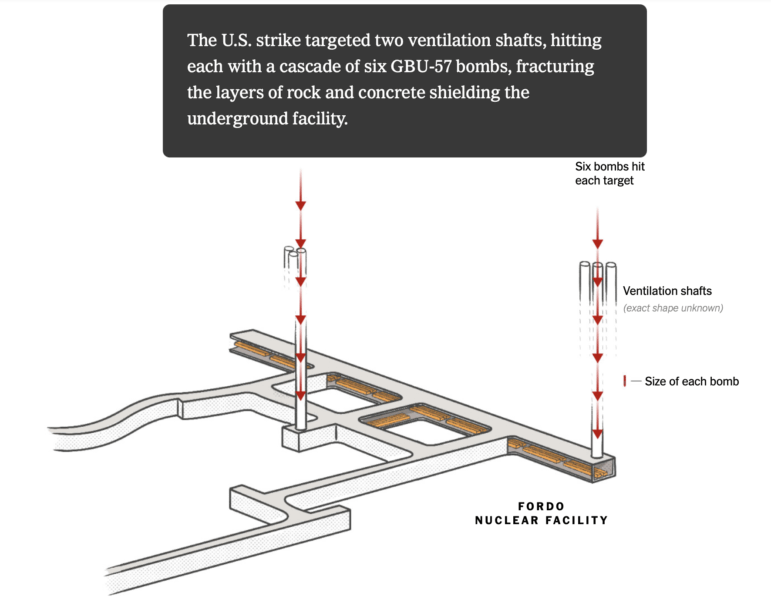
Image: Screenshot, The New York Times
In late June, US B-2 bombers carried out a series of airstrikes on Iranian nuclear facilities that housed the country’s uranium enrichment program. One of the central targets was an underground facility at Fordo, where Iran is believed to have numerous centrifuges buried in bunkers between 260 to 360 feet deep. In this analysis, The New York Times took a close look at the GBU-57 Massive Ordnance Penetrator bombs used, their possible pathways down into the facility, and the local geology of the rock protecting the bunker to try to understand how much damage the airstrikes inflicted. Their conclusion: the bombs likely did not reach the chambers housing the centrifuges, but the shock waves from the successive attacks did, probably causing “significant damage.”
Reconstructing the Environmental Legacy of Colonization in Namibia
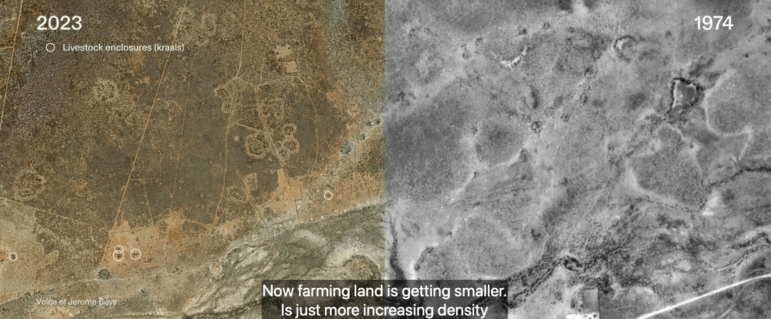
Image: Screenshot, Forensic Architecture
Germany colonized Namibia in the 19th century and, after a campaign of ethnic cleansing, instituted a commercial farming regimen on the land that radically reshaped the ecosystem and the Indigenous peoples, leaving a legacy that extends to today. The digital investigation site Forensic Architecture did a deep dive into the character of the land from 150 years ago compared to now, using oral testimony, archival documents, and site photography. It found that native grasslands have been replaced by bush, scrub trees, and grazing for livestock, leaving less and less land for individual farmers as well as fewer animal species.
Bonus: Tribute to Ozzy Osbourne

Image: Screenshot, South China Morning Post
Last month, the music world mourned the loss of the Prince of Darkness. Ozzy Osbourne, the legendary Black Sabbath frontman, shared one last triumphant show with a farewell concert in his hometown of Birmingham, UK, before he passed away. The South China Morning Post honored his life with a visually stunning tribute, charting his journey from childhood to global fame. They illustrate his renowned tattoos and create detailed treemaps of his best-selling albums, both with Black Sabbath and as a solo artist. Drawing on Ozzy’s autobiography, Spotify, and Chartmasters, the team also charted the posthumous surge in streams of his seminal solo tracks and Black Sabbath classics, celebrating the enduring legacy of a rock icon.
Hanna Duggal is a data journalist at AJ Labs, the data, visual storytelling, and experiments team of Al Jazeera and a GIJN contributor. She has reported on issues such as policing, surveillance, and protests using data, and reported for GIJN on data journalism in the Middle East, investigating algorithms onTikTok, and on using data to investigate tribal lands in the US.

